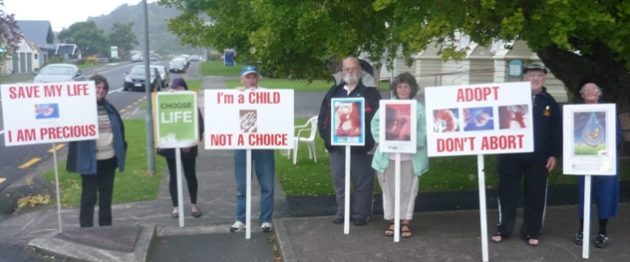by Scott Summerfield, ALRANZ Executive Board
You are on your way to the hospital. Something has come up, and you only have a short time to seek medical help before your life is changed forever. You are anxious, a million thoughts running through your mind, but you are resolved. You know you need to do this. You drive past a corner occupied by protesters. They have banners and signs that after a quick glance you know are directly targeting you. An older man catches your eye briefly; he knows nothing, but the look for you is a full on assault. It carries judgement, scorn, belittlement. You park, get out of the car, and walk past the protesters again into the hospital. One of them has given you a leaflet. Saying nothing, it goes into your bag. The hospital doors slide shut behind you, closing out the world and the protesters. What they are saying may affect you for months to come.
Are you:
- A man getting a vasectomy?
- A man taking his child for chemotherapy?
- A woman seeking a surgical abortion at 9 weeks?
- A woman coming to get an influenza vaccination?
The answer is clearly c). It is only ever c). People seeking abortion services are the only ones whose attempt to procure personal health treatment is met with protest outside clinics and hospitals. Prayer vigils and placards telling them they are making a terrible mistake, that their choice is immoral, and worse. This will in almost all cases only affect women. Protests against women accessing abortion are frequent, calculated and cruel. This is about harassment.
These protests and protesters cause harm when they harass women seeking an abortion. A 2015 UK study demonstrated that women feel intimidated, fearful, uncomfortable in the presence of protesters. The Abortion Supervisory Committee in New Zealand has raised this matter with Parliament, in 2013, stating that “Harassment of those seeking or providing abortion services remains a significant concern to the Committee.”
And it is certainly harassment. Anti-abortion protest is explicitly about controlling the choices of women. The anti-abortion movement here, and internationally, is not a peaceful one, utilising shock, invasive imagery, threats, abuse, and even violence. With abortion law reform, it’s entirely possible that abortion services in New Zealand may move away from the anonymity of hospitals to specialised clinics, which will make the protests more targeted and likely much more aggressive.
Preventing harassment and intimidation of people seeking abortion services must be undertaken through government legislation because, frankly, nothing else will work. Three states and two territories in Australia have implemented safe access zones where it is illegal to protest outside an abortion clinic. Safe access zones exist in parts of Canada, the USA, the UK, and are likely to be introduced in Ireland.
Our government is committed to abortion law reform. Safe access zones outside abortion clinics and hospitals must be a part of this reform. Until we can ensure that women and others in need of abortion services from a clinic or hospital can access those services without intimidation, harassment, judgement, or even violence, we will not have safe access to abortion in this country.

